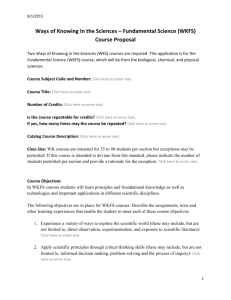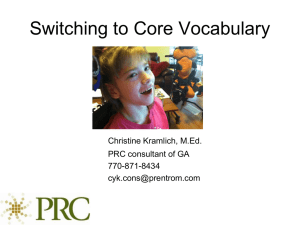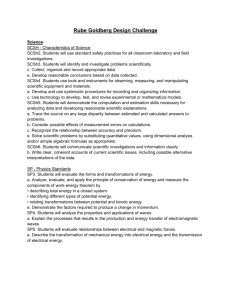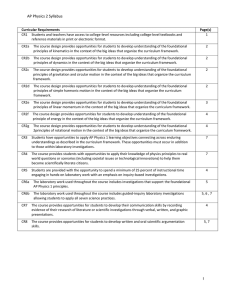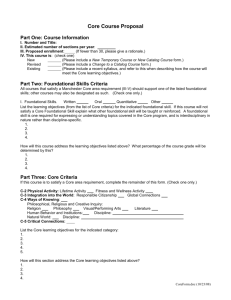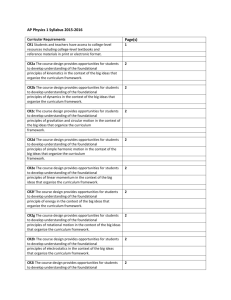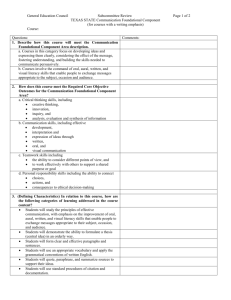AP Physics 1 Syllabus Wes Evans Midway High School Waco
advertisement
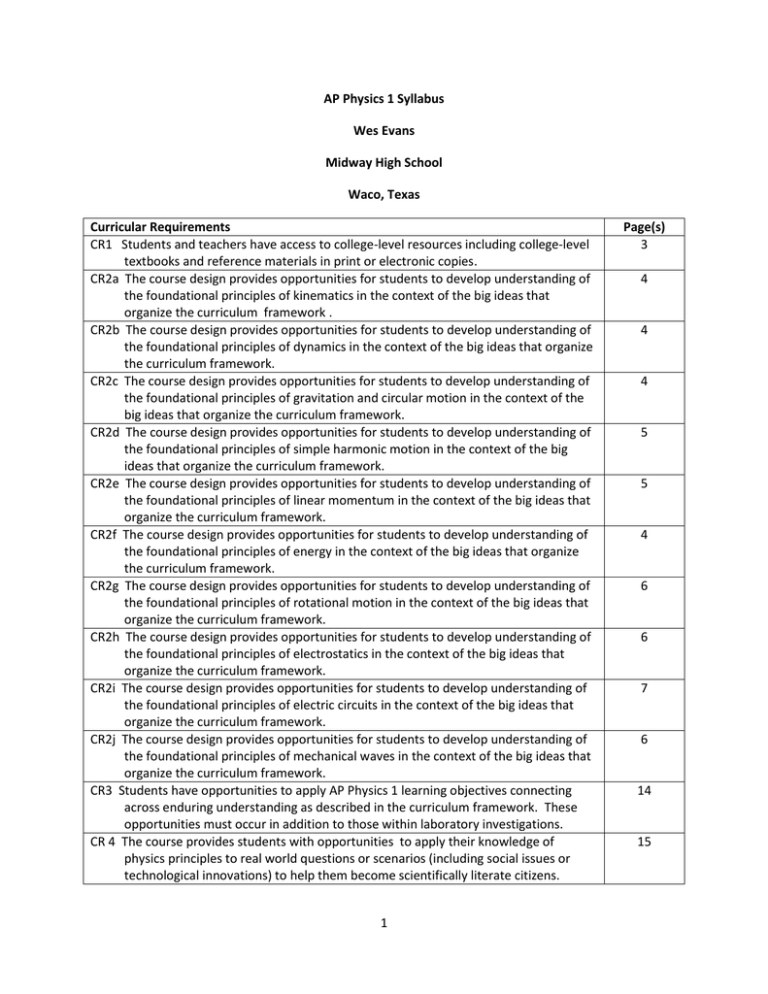
AP Physics 1 Syllabus Wes Evans Midway High School Waco, Texas Curricular Requirements CR1 Students and teachers have access to college-level resources including college-level textbooks and reference materials in print or electronic copies. CR2a The course design provides opportunities for students to develop understanding of the foundational principles of kinematics in the context of the big ideas that organize the curriculum framework . CR2b The course design provides opportunities for students to develop understanding of the foundational principles of dynamics in the context of the big ideas that organize the curriculum framework. CR2c The course design provides opportunities for students to develop understanding of the foundational principles of gravitation and circular motion in the context of the big ideas that organize the curriculum framework. CR2d The course design provides opportunities for students to develop understanding of the foundational principles of simple harmonic motion in the context of the big ideas that organize the curriculum framework. CR2e The course design provides opportunities for students to develop understanding of the foundational principles of linear momentum in the context of the big ideas that organize the curriculum framework. CR2f The course design provides opportunities for students to develop understanding of the foundational principles of energy in the context of the big ideas that organize the curriculum framework. CR2g The course design provides opportunities for students to develop understanding of the foundational principles of rotational motion in the context of the big ideas that organize the curriculum framework. CR2h The course design provides opportunities for students to develop understanding of the foundational principles of electrostatics in the context of the big ideas that organize the curriculum framework. CR2i The course design provides opportunities for students to develop understanding of the foundational principles of electric circuits in the context of the big ideas that organize the curriculum framework. CR2j The course design provides opportunities for students to develop understanding of the foundational principles of mechanical waves in the context of the big ideas that organize the curriculum framework. CR3 Students have opportunities to apply AP Physics 1 learning objectives connecting across enduring understanding as described in the curriculum framework. These opportunities must occur in addition to those within laboratory investigations. CR 4 The course provides students with opportunities to apply their knowledge of physics principles to real world questions or scenarios (including social issues or technological innovations) to help them become scientifically literate citizens. 1 Page(s) 3 4 4 4 5 5 4 6 6 7 6 14 15 Curricular Requirements CR5 Students are provided with the opportunity to spend a minimum of 25 percent of instructional time engaging in hands-on laboratory work with an emphasis on inquiry-based investigations. CR6a The laboratory work used throughout the course includes investigations that support the foundational AP Physics 1 principles CR6b The laboratory work used throughout the course includes guided-inquire laboratory investigations allowing students to apply all seven science principles CR 7 The course provides opportunities for students to develop their communication skills by recording evidence of their research of literature or scientific investigations through verbal, written and graphic presentations. CR8 The course provides opportunities for students to develop written and oral scientific argumentation skills. 2 Page(s) 5, 7 8, 9, 10, 11, 12 8, 9, 10, 11, 12, 13 7 16 RESOURCES Textbook John D. Cutnell, Kenneth W. Johnson. Physics. New York, NY: John Wiley and Sons, 2001. [CR1] Teaching Resources Etkina, Eugina, Michael Gentile and Alan Van Heuvelen. College Physics. San Francisco, CA: Pearson, 2014. Walker, James. Physics. San Francisco, CA: Addison Wesley, 2010. Freedman, Roger, Todd Russell, Philip Kesten, David Tauck. College Physics. New York, NY: W. H Freeman and Company, 2014. Giordano, Nicholas. College Physics, Reasoning and Relationships. Boston, MA: Cenage Learning, 2015. INSTRUCTIONAL STRATEGIES The AP Physics 1 course is conducting using inquiry-based instructional strategies that focus on experimentation to develop students’ conceptual understanding of physics principles. The students begin studying a topic by making observations and discovering patterns of natural phenomenon. The next steps involve developing, testing, and applying models. Throughout the course, the students construct and use multiple representations of physical processes, solve multi-step problems, design investigations and reflect on knowledge construction through self-assessment rubrics. In most labs, the students use probeware technology in data acquisition. In the classroom, they use graphing calculators and digital devices for interactive simulations, collaborative activities and formative assessments. 3 CR1 Students and teachers have access to college-level resources including college-level textbooks and reference materials in print or electronic copies. COURSE SYLLABUS Unit 1, Kinematics [CR2a] Kinematics in one-dimension: constant velocity and uniform accelerated motion Vectors: vector components and resultant Kinematics in two-dimensions: projectile motion Big Idea 3 CR2a The course design provides opportunities for students to develop understanding of the foundational principles of kinematics in the context of the big ideas that organize the curriculum framework . Learning Objectives: 3.A.1.1, 3.A.1.2, 3.A.1.3 Unit 2, Dynamics [CR2b] Forces, types and representations (free body diagrams) Newton’s First Law Newton’s Second Law Newton’s Third Law Application of Newton’s Second Law Friction Interacting objects: ropes and pulleys CR2b The course design provides opportunities for students to develop understanding of the foundational principles of dynamics in the context of the big ideas that organize the curriculum framework. Big Ideas 1, 2, 3, 4 Learning Objectives: 1.C.1.1, 1.C.1.3, 2.B.1.1, 3.A.2.1, 3.A.3.1, 3.A.3.2, 3.A,3.3, 3.A.4.1, 3.A.4.2, 3.A.4.3, 3.B.1.1, 3.B.1.2, 3.B.1.3, 3.B.2.1, 3.C.4.1, 3.C.4.2, 4.A.1.1, 4.A.2.1, 4.A.2.2, 4.A.2.3, 4.A.3.1, 4.A.3.2 Unit 3, Circular Motion and Gravitation [CR2c] Uniform circular motion Dynamics of uniform circular motion Universal Law of Gravitation Big Ideas 1, 2, 3, 4 Learning Objectives: 1.C.3.1, 2.B.1.1, 2.B.2.1, 2.B.2.2, 3.A.3.1, 3.A.3.3, 3.B.1.2, 3.B.1.3, 3.B.2.1, 3.C.1.1, 3.C.1.2, 3.C.2.1, 3.C.2.2, 3.G.1.1, 4.A.2.2 4 CR2c The course design provides opportunities for students to develop understanding of the foundational principles of gravitation and circular motion in the context of the big ideas that organize the curriculum framework. CR2f The course design provides opportunities for students to develop understanding of the foundational principles of energy in the context of the big ideas that organize the curriculum framework. Unit 4, Energy [CR2f] Work Power Kinetic Energy Potential energy: gravitational and elastic Conservation of energy Big Ideas 3, 4, 5 Learning Objectives: 3.E.1.1, 3.E.1.2, 3.E.1.3, 3.E.1.4, 4.C.1.1, 4.C.1.2, 4.C.2.1, 4.C.2.2, 5.A.2.1, 5.B.1.1, 5.B.1.2, 5.B.2.1, 5.B.3.1, 5.B.3.2, 5.B.3.3, 5.B.4.1, 5.B.4.2, 5.B.5.1, 5.B.5.2, 5.B.5.3, 5.B.5.4, 5.B.5.5, 5.D.1.1, 5.D.1.1, 5.D.1.2, 5.D.1.3, 5.D.1.4, 5.D.1.5, 5.D.2.1, 5.D.2.3 Unit 5 Momentum [CR2e] CR2e The course design provides opportunities for students to develop understanding of the foundational principles of linear momentum in the context of the big ideas that organize the curriculum framework. Impulse Momentum Conservation of momentum Elastic and inelastic collision Big Ideas 3, 4, 5 Learning Objectives: 3.D.1.1, 3.D.2.1, 3.D.2.2, 3.D.2.3, 3.D.2.4, 4.B.1.1, 4.B.1.2, 4.B.2.1, 4.B.2.2, 5.A.2.1, 5.D.1.1, 5.D.1.2, 5.D.1.3, 5.D.1.4, 5.D.1.5, 5.D.2.1, 5.D.2.2, 5.D.2.3, 5.D.2.4, 5.D.2.5, 5.D.3.1 Unit 6, Simple Harmonic Motion [CR2d] Linear restoring forces and simple harmonic motion Simple harmonic motion graphs Simple pendulum Mass-spring system Big Ideas 3, 5 CR2d The course design provides opportunities for students to develop understanding of the foundational principles of simple harmonic motion in the context of the big ideas that organize the curriculum framework. Learning Objectives: 3.B.3.1, 3.B.3.2, 3.B.3.3, 3.B.3.4, 5.B.2.1, 5.B.3.1, 5.B.3.2, 5.B.3.3, 5.B.4.1, 5.B.4.2 5 Unit 7, Rotational Motion [CR2g] CR2g The course design provides opportunities for students to develop understanding of the foundational principles of rotational motion in the context of the big ideas that organize the curriculum framework. Torque Center of mass Rotational kinematics Rotational dynamics and rotational inertia Rotational energy Angular momentum Conservation of angular momentum Big Ideas 3, 4, 5 Learning Objectives: E.F.1.1, 3.F.1.2, 3.F.1.3, 3.F.1.4, 3.F.1.5, 3.F.2.1, 3.F.2.2, 3.F.3.1, 3.F.3.2, 3.F.3.3, 4.A.1.1, 4.D.1.1, 4.D.1.2, 4.D.2.1, 4.D.2.2, 4.D.3.1, 4.D.3.2, 5.E.1.1, 5.E.1.2, 5.3.2.1 Unit 8, Mechanical Waves, [CR2j] CR2j The course design provides opportunities for students to develop understanding of the foundational principles of mechanical waves in the context of the big ideas that organize the curriculum framework. Traveling waves Wave characteristics Sound Superposition Standing waves on a string Standing sound waves Big Idea 6 Learning Objectives: 6.A.1.1, 6.A.1.2, 6.A.1.3, 6.A.2.1, 6.A.3.1, 6.A.4.1, 6.B.1.1, 6.B.2.1, 6.B.4.1, 6.B.5.1, 6.D.1.1, 6.D.1.2, 6.D.1.3, 6.D.2.1, 6.D.3.1, 6.D.3.2, 6.D.3.3, 6.D.3.4, 6.D.4.1, 6.D.4.2, 6.D.5.1 Unit 9, Electrostatics [CR2h] Electric charge and conservation of charge Electric force: Coulomb’s Law Big Ideas 1, 3, 5 Learning Objectives: 1.B.1.1, 1.B.1.2, 1.B.2.1, 1.B.3.1, 3.C.2.1, 3.C.2.2, 5.A.2.1 6 CR2h The course design provides opportunities for students to develop understanding of the foundational principles of electrostatics in the context of the big ideas that organize the curriculum framework. Unit 10, DC Circuits [CR2i] CR2i The course design provides opportunities for students to develop understanding of the foundational principles of electric circuits in the context of the big ideas that organize the curriculum framework. Electric resistance Ohm’s Law DC circuits Series and parallel connections Kirchoff’s Laws Big Ideas 1, 5 Learning Objectives: 1.B.1.1, 1.B.1.2, 1.E.2.1, 5.B.9.1, 5.B.9.2, 5.B.9.3, 5.C.3.1, 5.C.3.2, 5.C.3.3 LABORATORY INVESTIGATIONS AND THE SCIENCE PRACTICES CR5 Students are provided with the opportunity to spend The AP Physics 1 course devotes over 25% of the time to laboratory practices a minimum of 25 percent of [CR5]. The laboratory component of the course allows the students to instructional time engaging in demonstrate the seven science practices through a variety of investigations in hands-on laboratory work with all of the foundational principles. an emphasis on inquiry-based The students used guided-inquiry (GI) or open-inquiry (OI) in the design of their investigations. laboratory investigations. Some labs focus on investigating a physical phenomenon with having expectations of its outcomes. In other experiments, the student has an expectation of its outcome based on concepts constructed from prior experiences. In application experiments, the students use acquired physics principles to address practical problems. Students also investigate topicrelated questions that are formulated through student designed/selected procedures. All investigations are reported in a laboratory journal. Students are expected to record their observations, data and data analyses. Data analyses include identification of the sources and effects of experimental uncertainty, calculations, results and conclusions, and suggestions for further refinement of the experiment as appropriate. [CR7] 7 CR 7 The course provides opportunities for students to develop their communication skills by recording evidence of their research of literature or scientific investigations through verbal, written and graphic presentations. LAB INVESTIGATION OBJECTIVES (Investigation identifier: GI = Guided Inquiry; OI = Open-Inquiry) Unit 1, Kinematics [CR6a] 1. Graphing Position vs Time [GI] [CR6b] Students design a lab using CPO photogates and tracks to find the speed of a cart. CR6a The laboratory work used throughout the course includes investigations that support the foundational AP Physics 1 principles Science Practices. 1.1, 1.2, 1.4, 2.1, 2.2, 3.1, 4.1, 4.2, 4.3, 5.1, 5.2, 5.3, 6.1, 6.2, 6.4, 7.2 2. Graph matching (GI) [CR6b] Students determine the proper placement of a cart on a track to produce motion that matches a given set of position vs time and velocity vs time graph. Science Practices. 1.2, 1.5, 2.1, 2.2, 3.1, 4.1, 4.2, 4.3, 5.1, 5.3, 6.1, 6.4, 7.2 3. Force Table (GI) [CR6b] Students use a force table to find the resultant of several vectors, and then compare this value to values obtained through calculated and graphical methods. Science Practices. 1.1 1.2, 1.4, 2.1, 2.2, 3.1, 4.1, 4.2, 4.3, 5.3, 6.1, 6.4, 7.2 4. Hit the Target (GI) [CR6b] Students use a CPO track and photogate to find the initial velocity of a projectile launched horizontally. They will then predict where the projectile will land by placing a target at that location. Science Practices. 1.4, 1.5, 2.1, 2.2, 3.1, 4.1, 4.2, 4.3, 5.3, 6.1, 6.4, 7.2 8 CR6b The laboratory work used throughout the course includes guided-inquire laboratory investigations allowing students to apply all seven science principles Unit 3, Dynamics [CR6a] 5. Newton’s Second Law (OI) [CR6b] Students determine the variation of the acceleration of a dynamics cart in two scenarios: 1) the total mass of the system is kept constant while the net force varies and 2) the net force is kept constant while the total mass of the system varies. CR6a The laboratory work used throughout the course includes investigations that support the foundational AP Physics 1 principles Science Practices. 1.1, 1.4, 1.5, 2.1, 2.2, 3.1, 3.2, 3.3, 4.1, 4.2, 4.3, 5.1, 5.2, 5.3, 6.1, 6.2, 6.4, 7.2 6. Coefficient of Friction (GI) [CR6b] Students design a lab using a CPO track, sled and photogates to determine the coefficient of kinetic friction between the sled and track Science Practices. 1.1, 1.4, 1.5, 2.1, 2.2, 3.1, 4.1, 4.2, 4.3, 5.3, 6.1, 6.4, 7.2 7. Atwood’s Machine (GI) [CR6b] Students design a lab to find the acceleration and tension for a mass suspended from an Atwood’s machine. Science Practices. 1.1, 1.4, 1.5, 2.1, 2.2, 3.1, 4.1, 4.2, 4.3, 5.3, 6.1, 6.4, 7.2 Unit 3, Circular Motion and Gravitation [CR6b] 8. Centripetal Force (GI) [CR6b] Students design a lab to find the mass on the end of a string whirled in a circular path. Science Practices 1.1, 1.2, 1.4, 1.5, 2.1, 2.2, 3.1, 4.1, 4.2, 4.3, 5.3, 6.1, 6.4, 7.2 9 CR6b The laboratory work used throughout the course includes guided-inquire laboratory investigations allowing students to apply all seven science principles Unit 4, Energy [CR6a] 9. Loop Track Students us a loop track and CPO photogates to verify conservation of energy for a ball that rolls along the track CR6a The laboratory work used throughout the course includes investigations that support the foundational AP Physics 1 principles Science Practices. 1.1, 1.2, 1.3, 1.4, 1.5, 2.1, 2.2, 3.1, 4.1, 4.2, 4.3, 5.3, 6.1, 6.2, 6.4, 7.2 10. Work Done in Stretching a Spring (GI) [CR6b] Students design a lab to find the work done on a spring from force vs distance graph for the collected data Science Practices. 1.1, 1.2, 1.3, 1.4, 1.5, 2.1, 2.2, 3.1, 4.1, 4.2, 4.3, 5.3, 6.1, 6.4, 7.2 11. CR6b The laboratory work used throughout the course includes guided-inquire laboratory investigations allowing students to apply all seven science principles Energy and Non-Conservative Forces (GI) [CR6b] Students design an experiment using a CPO track, sled and photogate to determine the energy dissipated by friction as the sled slides down the track. Science Practices. 1.1, 1.2, 1.3, 1.4, 1.5, 2.1, 2.2, 3.1, 4.1, 4.2, 4.3, 5.3, 6.1, 6.4, 6.5, 7.2 Unit 5, Momentum [CR6a] 12. Conservation of Momentum Students verify conservation of energy for two carts that collide on a Pasco track using data from position vs time graphs generated in real time. CR6a The laboratory work used throughout the course includes investigations that support the foundational AP Physics 1 principles Science Practices. 1.1, 1.2, 1.3, 1.4, 1.5, 2.1, 2.2, 3.1, 4.1, 4.3, 4.4, 5.1, 5.2, 5.3, 6.1, 6.2, 6.4, 7.2 13. Impulse and Momentum (GI) [CR6b] Students design a lab using CPO track, photogates, carts and elastic bumper to find the impulse for the cart rebounding from the bumper. Science Practices. 1.1, 1.2, 1.3,1.4, 1.5, 2.1, 2.2, 3.1, 4.1, 4.2, 4.3, 5.1, 5.3, 6.1, 6.4, 7.2 10 CR6b The laboratory work used throughout the course includes guided-inquire laboratory investigations allowing students to apply all seven science principles 14. Elastic and Inelastic Collisions (OI) [CR6b] Students investigate conservation of momentum and conservation of energy using a ballistic pendulum to determine the type of collision. Science Practices. 1.1., 1.2, 1.3, 1.4, 1.5, 2.1, 2.2, 3.1, 4.1, 4.2, 4.3, 5.1, 5.2, 5.3, 6.1, 6.2, 6.4, 7.2 CR6b The laboratory work used throughout the course includes guided-inquire laboratory investigations allowing students to apply all seven science principles Unit 6, Simple Harmonic Motion [CR6a] 15. Spring Constant (GI) [CR6b] Students will design two independent experiments to find the spring constant of a given spring. Science Practices. 1.1, 1.4, 2.1, 2.2, 3.1, 4.1, 4.2, 4.3, 5.3, 6.1, 6.4, 7.2 16. Graphs of an Oscillating System (GI) [CR6b] Students will analyze graphs of position, velocity, and acceleration vs time for an oscillating system to determine how velocity and acceleration at the equilibrium and maximum displacement positions Science Practices. 1.1, 1.2, 1.4, 1.5, 2.1, 2.2, 3.1, 4.1, 4.2, 4.3, 5.1, 5.3, 6.1, 6.4, 7.2 17. Simple Pendulum (GI) [CR6b] Students will investigate the actors the affect the period of a simple pendulum and test whether the period is proportional to the period’s length, square of its length, or the square root of its length. Science Practices. 1.2, 1.4, 2.1, 2.2, 2.3, 3.1, 3.2, 3.3, 4.1, 4.2, 4.3, 5.1, 5.3, 6.1, 6.4, 7.2 Unit 7, Rotational Motion [CR6a] 18. Rotational Inertia (GI) [CR6b] Students will design an experiment using CPO rotational inertia apparatus and photogates to determine the rotational inertia from a graph of applied torque vs angular acceleration. Science Practices. 1.1, 1.2, 1.4, 1.5, 2.1, 2.2, 3.1, 4.1, 4.2, 4.3, 5.1, 5.3, 6.1, 6.4, 7.2 11 CR6a The laboratory work used throughout the course includes investigations that support the foundational AP Physics 1 principles 19. Conservation of Angular Momentum (GI) [CR6b] Conservation of Angular Momentum Students will design an experiment to determine how the momentum of a rotating system responds to changes in the rotational inertia Science Practices. 1.1, 1.2, 1.4, 1.5, 2.1, 2.2, 3.1, 4.1, 4.2, 4.3, 5.1, 5.3, 6.1, 6.4, 7.2 CR6b The laboratory work used throughout the course includes guided-inquire laboratory investigations allowing students to apply all seven science principles Unit 8, Mechanical Waves [CR6a] 20. Speed of a Wave on a String (GI) [CR6b] Students design an experiment using a CPO wiggler and graph various frequencies vs length of the standing wave created. Science Practices. 1.1, 1.2, 1.4, 1.5, 2.1, 2.2, 3.1, 4.1, 4.2, 4.3, 5.3, 6.1, 6.4, 7.2 21. Speed of Sound (GI) [CR6b] Students design an experiment using both open and closed tubes to find the speed of sound in air. Science Practices. 1.1, 1.2, 1.4, 1.5, 2.1, 2.2, 3.1, 4.1, 4.2, 4.3, 5.3, 6.1, 6.4, 7.2 22. Reflection of Waves (GI) [CR6b] Students compare reflection and phase change of a transverse wave on a spring when a pulse is reflected and transmitted between various media Science Practices. 1.4, 3.1, 5.1, 6.1, 6.4, 7.2 Unit 9, Electrostatics [CR6a] 23. Static Electricity Interactions (GI) [6Rb] Students use sticky tape and a variety of objects to make qualitative observations of the interactions when the objects are charged, discharged and recharged. Science Practices. 1.4, 3.1, 4.1, 4.2, 4.3, 5.1, 6.1, 6.4, 7.2 12 CR6a The laboratory work used throughout the course includes investigations that support the foundational AP Physics 1 principles 24. Coulomb’s Law (GI) [CR6b] Students will estimate the charge on two identical, equally charged spherical pith balls of known mass. Science Practices. 1.1, 1.2, 1.4, 1.5, 2.1, 2.2, 3.1, 4.1, 4.2, 4.3, 5.1, 5.3, 6.1, 6.4, 7.2 Unit 10, Circuits [CR6a] 25. Brightness Investigation (GI) [CR6b] Students will make predictions about the brightness of light bulbs in a variety of series and parallel circuits when some of the bulbs are removed. Science Practices. 1.2, 3.1, 4.1, 4.2, 4.3, 5.3, 6.1, 6.4, 7.2 26. Voltage and Current (GI) [CR6b] Students will determine the relationship between current through a resistor and the voltage across the resistor. Science Practices. 1.1, 1.2, 1.4, 1.5, 2.1, 2.2, 3.1, 4.1, 4.2, 4.3, 5.1, 5.3, 6.1, 6.4, 7.2 27. Series and Parallel Circuits (GI) [CR6b] Students investigate the behavior of resistors in series, parallel and series-parallel circuits. The labs should include measurements of voltage and current. Science Practices. 1.1, 1.2, 1.4, 1.5, 2.1, 2.2, 3.1, 4.1, 4.2, 4.3, 5.1, 5.2, 5.3, 6.1, 6.4, 7.2 13 CR6b The laboratory work used throughout the course includes guided-inquire laboratory investigations allowing students to apply all seven science principles INSTRUCTIONAL ACTIVITIES Throughout the course, the students engage in a variety of activities designed to build the student’s reasoning skills and deepen their conceptual understanding of physics principles. Students conduct activities and projects that enable them to connect the concepts learned in class to real world applications. Examples of activities are described below. 1. PROJECT DESIGN [CR3] Students engage in hands-on activities outside of the laboratory experience that support the connection to more than one Learning Objective. ACTIVITY: Roller Coaster Investigation DESCRIPTION Working in groups of three, students design a simple roller coaster using provided materials (a track with a vertical loop and toy cars) to test whether the total energy of a car-Earth system is conserved if there are no external forces exerted on it by other objects. Students include multiple representations of energy to provide evidence for their claims. Students us a bar chart, the mathematical expression of conservation of energy represented by the graph, and the corresponding calculations to evaluate whether the outcome of the experiment supports the idea of energy conservation. This activity is designed to allow students to apply the following Learning Objectives: Learning Objective 5.B.3.1 The student is able to describe and make qualitative and/or quantitative predictions about everyday examples of systems with internal potential energy. Learning Objective 5.B.3.2 The student is able to make quantitative calculations of the internal potential energy of a system from a description or diagram of that system. Learning Objective 5.B.3.3 The student is able to apply mathematical reasoning to create a description of the internal potential energy of a system from description or diagram of the objects and interactions of that system. 14 CR3 Students have opportunities to apply AP Physics 1 learning objectives connecting across enduring understanding as described in the curriculum framework. These opportunities must occur in addition to those within laboratory investigations. Learning Objective 5.B.4.2 The student is able to calculate changes in kinetic energy and potential energy of a system, using information from representations of that system. Learning Objective 4.C.1.1 The student is able to calculate the total energy of a system and justify the mathematical routines used in the calculation of component types of energy within the system whose sum is the total energy. Learning Objective 4.C.1.2 The student is able to predict changes in the total energy of a system due to changes in position and speed of objects or frictional interactions with the system. 2. REAL WORLD APPLICATION ACTIVITY: Torque and the Human Arm [CR4] DESCRIPTION This activity provides an opportunity for students to make an interdisciplinary connection to biological system by investigating the structure and function of a major muscle (biceps) in the human body. Students design and build an apparatus that replicates the forearm and biceps muscle system. The objective is to determine the biceps tension when holding an object in a lifted position. Students may use the Internet to research the structure of the biceps muscle. They can use readily available materials in the classroom, such as a meter stick, a ring stand, weight hangers an assortment of blocks, and a spring scale. In the lab journal, students are required to document the different stages of their design. Required elements include design sketches, force diagrams, mathematical representations of translational and rotational equilibrium, and numerical calculations. Learning Objective 3.F.1.1 The student is able to use representations of the relationship between fore and torque. Learning Objective 3.F.1.2 The student is able to compare the torque on an object caused by various forces. 15 CR 4 The course provides students with opportunities to apply their knowledge of physics principles to real world questions or scenarios (including social issues or technological innovations) to help them become scientifically literate citizens. Learning Objective 3.F.1.3 The student is able to estimate the toque on an object caused by various forces in comparison to other situations. Learning Objective 3.F.1.4 The student is able to design an experiment and analyze data testing a question about torques in a balanced rigid system. Learning Objective 3.F.1.5 The student is able to calculate torques on a two-dimensional system in static equilibrium by examining a representation or model (such as a diagram or physical construction. 3. Scientific Argumentation In this course students become familiar with the three components of scientific argumentation. The first element is the claim, which is the response to a prediction. A claim provides an explanation for why or how something happens in a laboratory investigation. The second component is the evidence, which supports the claim and consists of the analysis of the data collected during the investigation. The third component consists of questioning, in which students examine and defend one another’s claims. Students receive explicit instruction in posting meaningful questions that include questions of clarification, questions that probe assumptions and questions that probe implications and consequences. As a result of the scientific argumentation process, students are able to revise their claims and make revisions as appropriate. ACTIVITY 1: Formation Assessment: Changing Representations in Energy DESCRIPTION Students work in pairs to create exercises that involve translation from one representation to another. Some possible translations are: From a bar chart to a mathematical representation From a physical situation to a bar chart From a given equation to a bar chart Each pair of students exchanges their exercises with another pair. After the students work through the exercises they received, The pairs meet and offer constructive criticism (peer critique) on each other’ solutions. 16 CR 8 – The course provides opportunities for students to develop written and oral scientific argumentation skills Learning Objective 5.B.4.1 The student is able to describe and make predictions about the internal energy of everyday systems. Learning Objective 5.B.4.2 The student is able to calculate changes in kinetic energy and potential energy of a system using information from representations of that system. ACTIVITY 2. Laboratory Investigation Speed of Sound DESCRIPTION: Working in small groups, students design two different procedures to determine the speed of sound in air. They brainstorm their approaches and write them on the whiteboard. Each of the teams presents their ideas to the class. They receive feedback from their peers and then conduct their experiments. They record the revised procedures in the lab journals. During the post-lab discussion, the students discuss their results (evidence) by examining and defending one another’s claims. Then as a class we reach consensus about the estimated value for the speed of sound. Learning Objective 6.A.2.1 The student is able to describe sound in terms of transfer of energy and momentum in a medium and relate the concepts to everyday examples. Learning Objective 6.A.4.1 The student is able to explain and/or predict qualitatively how the energy carried by a sound wave relates to the amplitude of the wave, and/or apply this concept to a real world example. Learning Objective 6.B.4.1 The student is able to design an experiment to determine the relationship between period wave speed, wavelength, and frequency and relate these concepts to everyday examples. 17
